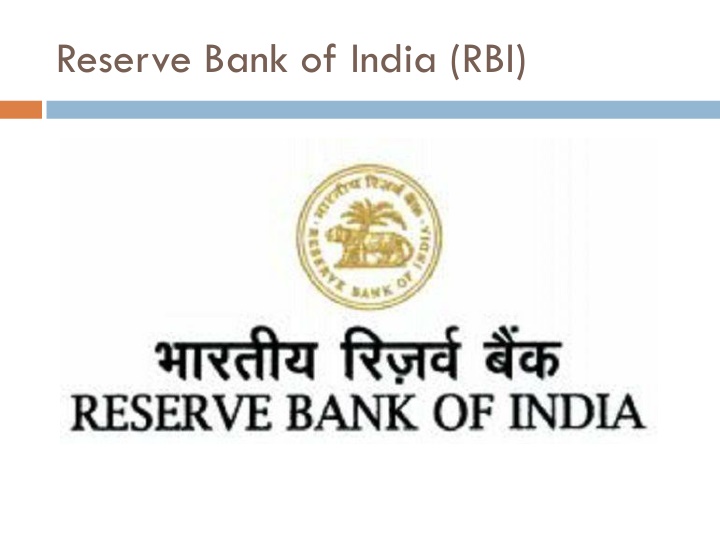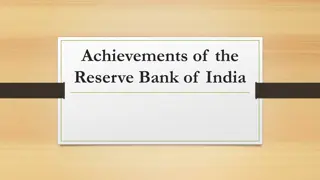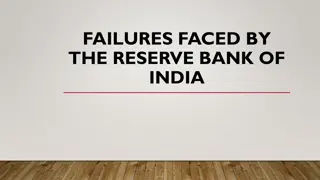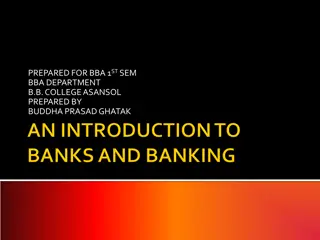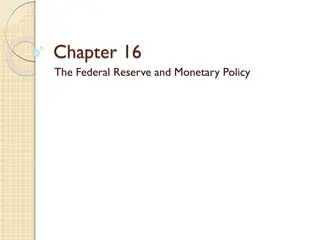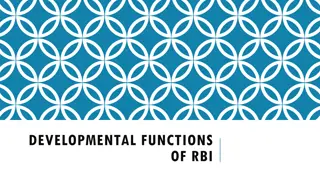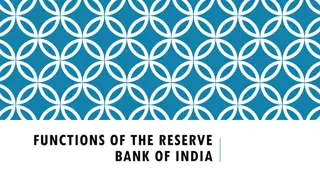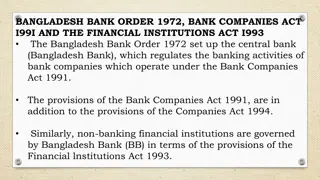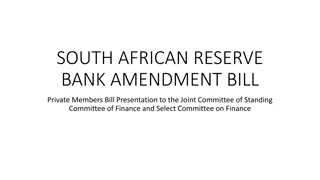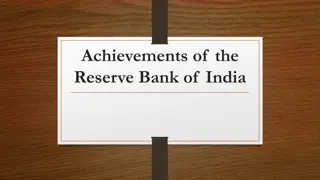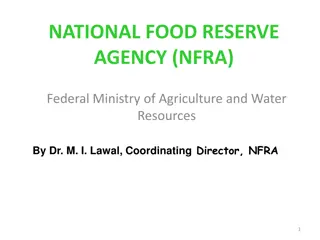Reserve Bank of India - Central Bank Established in 1935
The Reserve Bank of India, established in 1935, is the central bank of the country. It regulates banknotes, maintains reserves, and ensures monetary stability. Learn about its history, functions, and milestones.
Download Presentation

Please find below an Image/Link to download the presentation.
The content on the website is provided AS IS for your information and personal use only. It may not be sold, licensed, or shared on other websites without obtaining consent from the author.If you encounter any issues during the download, it is possible that the publisher has removed the file from their server.
You are allowed to download the files provided on this website for personal or commercial use, subject to the condition that they are used lawfully. All files are the property of their respective owners.
The content on the website is provided AS IS for your information and personal use only. It may not be sold, licensed, or shared on other websites without obtaining consent from the author.
E N D
Presentation Transcript
RESERVE BANK OF INDIA (RBI) The Reserve Bank of India is the central bank of the country. Central banks are a relatively recent innovation and most central banks, as we know them today, were established around the early twentieth century. The Reserve Bank of India was set up on the basis of the recommendations of the Hilton Young Commission. The Reserve Bank of India Act, 1934 (II of 1934) provides the statutory basis of the functioning of the Bank, which commenced operations on April 1, 1935.
The Beginnings -1926 to 1935 Date Event 1926 Royal Commission on Indian Currency (Hilton Young Commission) recommends the establishment of a central bank to be called the Reserve Bank of India 1931 Indian Central Banking Enquiry Committee revives the issue of the establishment of the Reserve Bank of India as the Central Bank for India. 5 March, 1934 Reserve Bank of India Act, 1934, (II of 1934) constitutes the statutory basis on which the Bank is established.
Establishment The Reserve Bank of India was established on April 1, 1935 in accordance with the provisions of the Reserve Bank of India Act, 1934. The Central Office of the Reserve Bank was initially established in Calcutta but was permanently moved to Mumbai in 1937. The Central Office is where the Governor sits and where policies are formulated. Though originally privately owned, since nationalisation in 1949, the Reserve Bank is fully owned by the Government of India.
Preamble The Preamble of the Reserve Bank of India describes the basic functions of the Reserve Bank as:"...to regulate the issue of Bank Notes and keeping of reserves with a view to securing monetary stability in India and generally to operate the currency and credit system of the country to its advantage."
Milestones The Reserve Bank of India is the central bank of the country. Central banks are a relatively recent innovation and most central banks, as we know them today, were established around the early twentieth century. The Reserve Bank of India was set up on the basis of the recommendations of the Hilton Young Commission. The Reserve Bank of India Act, 1934 (II of 1934) provides the statutory basis of the functioning of the Bank, which commenced operations on April 1, 1935.
The Bank was constituted to : Regulate the issue of banknotes, Maintain reserves with a view to securing monetary stability and to operate the credit and currency system of the country to its advantage. The Bank began its operations by taking over from the Government the functions so far being performed by the Controller of Currency and from the Imperial Bank of India, the management of Government accounts and public debt. The existing currency offices at Calcutta, Bombay, Madras, Rangoon, Karachi, Lahore and Cawnpore (Kanpur) became branches of the Issue Department. Offices of the Banking Department were established in Calcutta, Bombay, Madras, Delhi and Rangoon.
The Bank was constituted to : Burma (Myanmar) seceded from the Indian Union in 1937 but the Reserve Bank continued to act as the Central Bank for Burma till Japanese Occupation of Burma and later up to April, 1947. After the partition of India, the Reserve Bank served as the central bank of Pakistan up to June 1948 when the State Bank of Pakistan commenced operations. The Bank, which was originally set up as a shareholder's bank, was nationalized in 1949. An interesting feature of the Reserve Bank of India was that at its very inception, the Bank was seen as playing a special role in the context of development, especially Agriculture.
The Bank was constituted to : When India commenced its plan endeavors, the development role of the Bank came into focus, especially in the sixties when the Reserve Bank, in many ways, pioneered the concept and practice of using finance to catalyze development. The Bank was also instrumental in institutional development and helped set up institutions like the Deposit Insurance and Credit Guarantee Corporation of India, the Unit Trust of India, the Industrial Development Bank of India, the National Bank of Agriculture and Rural Development, the Discount and Finance House of India etc. to build the financial infrastructure of the country. With liberalization, the Bank's focus has shifted back to core central banking functions like Monetary Policy, Bank Supervision and Regulation, and Overseeing the Payments System and on to developing the financial markets.
Mgt. & Control RBI: Central Board :- The Reserve Bank's affairs are governed by a central board of directors. The board is appointed by the Government of India in keeping with the Reserve Bank of India Act. Appointed/nominated for a period of four years Constitution.
Official and Non-Official Directors Official Directors Non-Official Directors Nominated by Government: Ten Directors from various fields and two government Official. Others: four Directors- one each from four local boards. Full-time: Governor and not more than four Deputy Governors.
21 Member Central Board of Director 1 Governor [Shri Shaktikanta Das] 4 Deputy Governors 2 Officers appointed by Finance Ministry 10 Officers appointed by Government of India 4 Local boards Governor 4 Local boards [Mumbai, Calcutta, Chennai, New Delhi]
